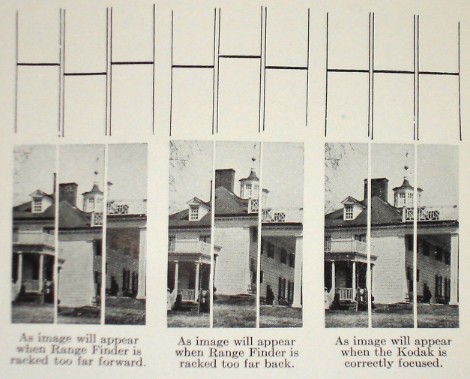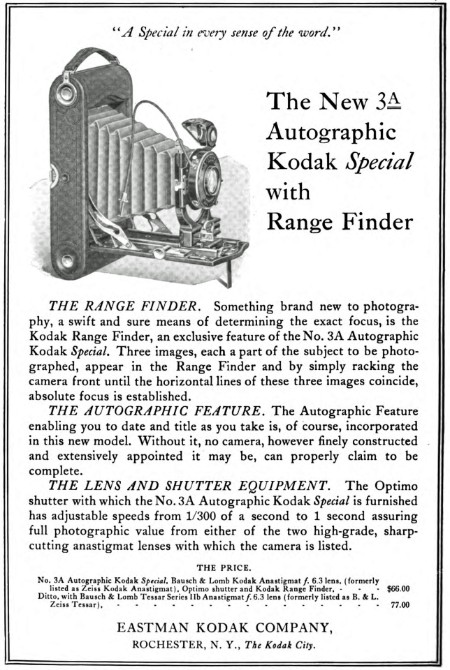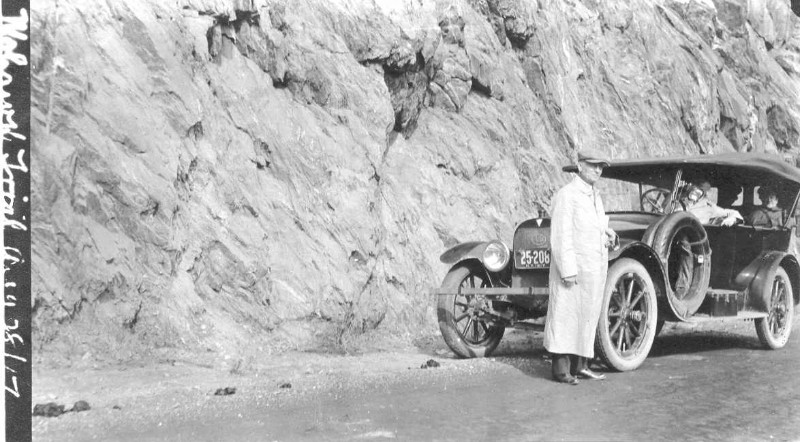No. 3A Autographic Kodak Special (1916 - 1937)
This is the first camera with a coupled rangefinder. Below the lens is a mechanism with tiny mirrors and lenses which produces a split image. By turning a knob on the side of the base board, the lens panel moves forward. The rangefinder is coupled with this movement and when the horizontal lines in the finder are aligned the camera is focused correctly.
The No. 3A Autographic Kodak Special with rangefinder takes pictures of 3 1/4 x 5 1/2 inch (about 8 x 14 cm) on A122 size roll film. The 'A' in A122 indicates that Autographic film should be used. This film permitted the photographer to write some notes on the film, which could be printed on the photo. A little door on the back of the camera gave access to the film. A small stylus was provided to write on the film. Read my article about the autographic feature (in Dutch).
The camera was a luxurious instrument, with fine leather and high quality lens and shutter. Prices depended on lens / shutter combinations and varied between $ 49 and $ 110. The most expensive one (the one in the video) had a Bausch & Lomb Tessar lens and Kodamatic shutter. Considering that the average income per year of a school teacher in 1920 was $ 970, the camera was an expensive instrument.
A number of variation were made over the years. The first model had a hidden button on the side to open the drop down bed. In October 1919 this was replaced by a 'plastic' visible button. From 1921 the folding reflecting finder was replaced by a rigid enclosed one. The specimen in the video with the B&L Tessar lens and Kodamatic shutter was made between 1921 and 1925.
In 1916 a military version of this camera was produced. Only 100 were made and it is extremely rare today.
A No. 1A Autographic Kodak Special with rangefinder was produced from 1917 until 1926 and a No. 2C Autographic Kodak Special with rangefinder was made from 1923 until 1928 in the USA and 1932 in the UK.
Some more information about the rangefinder
The Canadian Kodak Co. Ltd. Trade Circular of March 1916 explains why the rangefinder is useful: “Anything that makes picture taking easy, that does away with the probability of error, or improves photographic quality, means an increase in the army of amateurs. The Kodak Range Finder will make for greater efficiency. There are very many intelligent people, with money to spend and with a fondness for good pictures, who, unfortunately, are very poor judges of distance. The Kodak Range Finder will help them—and will help you in selling 3A Specials.”
The rangefinder is based on the invention of John Edward Woodbury of Worcester, Massachusetts. The US patent number is 01166032 of December 28, 1915. In Brittain he received patent number 13.421 in 1914.
The Autographic Kodak Special cameras are equiped with high quality fast lenses. However, when using the cameras with a large aperture the depth of field is shallow, especially at close range. Correctly setting the camera to the correct distance is very difficult. In addition, it is not easy to estimate the number of meters between camera and object. At close range a slight mistake results in ill-focused objects.

Detail from the instructions booklet, showing the image in the rangefinder. In real the image is not as clear as in this illustration.
| 
Ad in Popular Photography, April 1916. |

Photo taken with a No. 3A Autographic Kodak Special |

